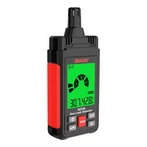Atomic Force Microscopy (AFM) System Structure
1. Force detection section:
In the system of atomic force microscopy (AFM), the force to be detected is the van der Waals force between atoms. So in this system, a cantilever is used to detect the changes in force between atoms. This micro cantilever has certain specifications, such as length, width, elasticity coefficient, and needle tip shape, and the selection of these specifications is based on the characteristics of the sample and different operating modes, and different types of probes are selected.
2 Position detection section:
In the system of atomic force microscopy (AFM), when there is interaction between the needle tip and the sample, the cantilever cantilever will swing. Therefore, when the laser is irradiated at the end of the cantilever, the position of the reflected light will also change due to the cantilever swing, resulting in the generation of offset. In the entire system, the laser spot position detector is used to record the offset and convert it into an electrical signal for signal processing by the SPM controller.
3 Feedback system:
In the atomic force microscope (AFM) system, after the signal is taken in by a laser detector, it is used as a feedback signal in the feedback system as an internal adjustment signal, and drives the scanner usually made of piezoelectric ceramic tubes to move appropriately to maintain the appropriate force between the sample and the needle tip.
Atomic force microscopy (AFM) combines the above three parts to present the surface characteristics of the sample: in the AFM system, a tiny cantilever is used to sense the interaction between the needle tip and the sample. This force will cause the cantilever to swing, and then the laser is used to irradiate the end of the cantilever. When the swing is formed, the position of the reflected light will change, causing an offset. At this time, the laser detector will record this offset and also provide the feedback system with the signal at this time to facilitate appropriate adjustment of the system. Finally, the surface characteristics of the sample will be presented in the form of an image.






